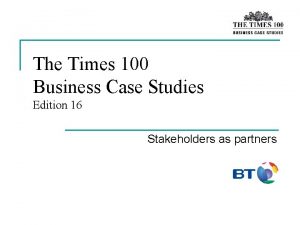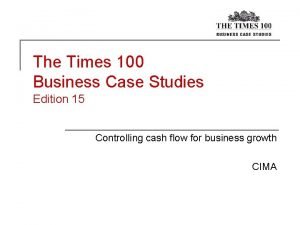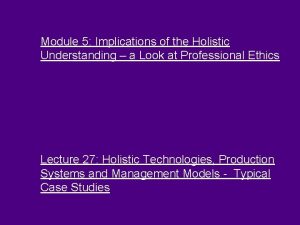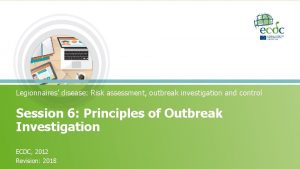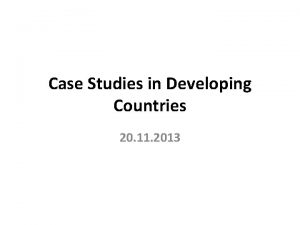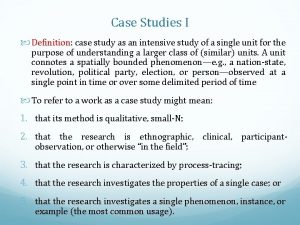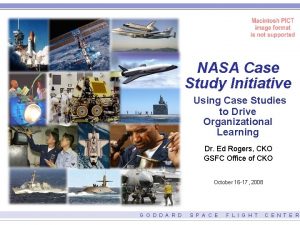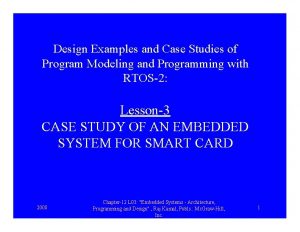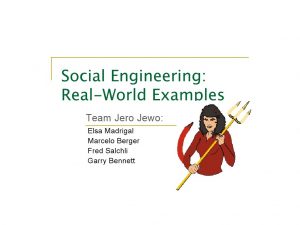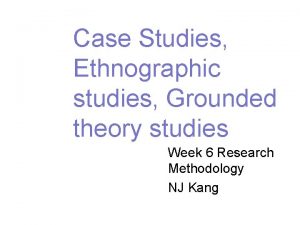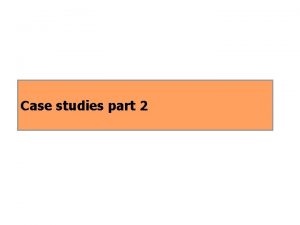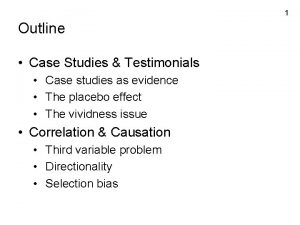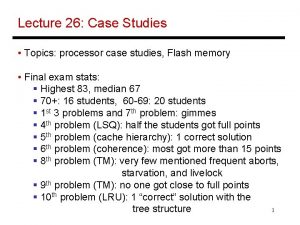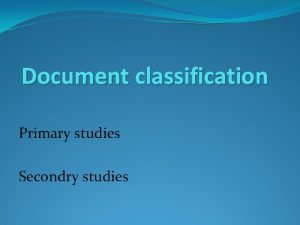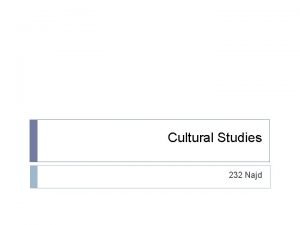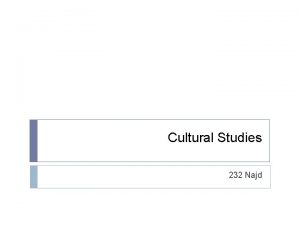Unit 11 Case studies What is a case
























- Slides: 24

Unit 11: Case studies What is a case study? 1. Ask students to discuss in small groups what the term case study means to them. 2. Also, ask them to mention a. some possible subjects for a case study (maybe some examples they know) a. reasons why they think a researcher would prefer to do a case study rather than e. g. a survey. © 2015 Kimmel 1

Definitions from the literature: – Case study research is an investigation and analysis of a single or collective case, intended to capture the complexity of the object of study. (Stake, 1995, ). – An empirical inquiry about a contemporary phenomenon (e. g. , a “case”), set within its real-world context—especially when the boundaries between phenomenon and context are not clearly evident (Yin, as cited in Yin, 2012, p. 4. ). – A case study is an approach to research that focuses on gaining an in-depth understanding of a particular entity or event at a specific time. (http: //isites. harvard. edu/icb. do? keyword=qualitative&pageid=icb. page 3403 44) © 2015 Kimmel 2

What can be the subject of a case study? A bounded entity, for example you may wish to understand: • one person ( e. g. a pupil) • a group/ a community (e. g. a group of pupils) • an organization/institution ( e. g. a school) • an event (e. g. a conference, a parents-teacher meeting) Either of the above are bounded in time (contemporary) and space (location). © 2015 Kimmel 3

When to do a case study? If we want to get answers to research questions starting with: How…. . ? Why……. ? If the researcher lacks control over what is happening. ( Yin, 2014, p. 11) Case studies help us understand 1. What is happening or happened? For example: What is everyday life like in a dormitory? 2. How and why did something happen? For example: Why is a school exceptionally successful in nurturing gifted students? © 2015 Kimmel 4

Types of case studies: what sort of research questions do they answer? 1. Descriptive case studies answer the question: What happened or is happening and how? 2. Explanatory case studies answer the questions: Why did it happen or is it happening? 3. Exploratory case studies: The researcher explores a case to be able to develop the research questions or the hypotheses, or identify the data collection tools, key participants for his/her subsequent research project. 4. Case studies may also be used to evaluate e. g. an innovative teaching method. © 2015 Kimmel 5

Other typologies • Single case versus multiple cases ( collective case ) • Intrinsic versus instrumental cases • Naturalist versus pragmatic © 2015 Kimmel 6

Where to start? Step 1: find your wondering Identify a problem: e. g. how does the long TP work? Create possible research questions: a. How is it implemented? (What is happening? ) b. How is the long teaching practice conceptualized by the different stakeholders? c. Why (based on what evidence) do relevant stakeholders rate the long teaching practice successful or not successful? © 2015 Kimmel 7

Step 2: consider if the case study method is suitable to research this topic What can the case study method provide for you that other methods cannot? 1. Work in small groups and collect the other research methods that you would/could use to answer the research questions above. Give the rationale behind your choices, too. Report back to the group. 2. Elicit from students how the research could benefit- if at allfrom the case study approach. © 2015 Kimmel 8

Step 3: select a case Which would be best to investigate? a. A typical case b. An easy to access case ( e. g. my ex-secondary school) c. An atypical case ( gyakorló iskola) d. A critical case ( e. g. where conflicts have been reported ) e. Multiple cases Gaining access then earning the trust of the participants. © 2015 Kimmel 9

Step 4: drawing up the case study protocol It needs to include • the questions the case study seeks to answer • the procedures to be followed in the field • the data that needs to be collected. It also describes how the questions are linked to the data to be collected. Two types of protocols: the preliminary protocol and the final protocol. © 2015 Kimmel 10

Most frequently used data collection methods in case studies • Direct observation • Participant observation • Interviews (e. g. open-ended conversations with key participants) • Document analysis (e. g. portfolio analysis) • Archival records (e. g. students’ records, competency test results) • Physical artifacts (e. g students’ project works, presentations) (based on Yin, 2012, p. 10) 11 © 2015 Kimmel

Choosing research tools and participants • Matching tools to the aims: decide what sort of data are needed to answer the research questions. • How to choose the participants? Seek out the key informants on the site based on experience and intuition. If the context is unknown, use the snowball method: find one key informant, and ask him/her to identify further key informants. 12 © 2015 Kimmel

Triangulation Aim: to increase the validity of the research. Data triangulation: collecting data about the same phenomenon using the same data collection method but from three different sources, e. g. interviewing mentors, mentees and students taught by the mentee about the perceived success of the long TP. Methodological triangulation: collecting data about the same phenomenon using three different data collection methods, e. g. portfolio (document) analysis, interview with mentor/mentee, and observing mentee’s lessons to see if the long teaching practice is successful is not. © 2015 Kimmel 13

Ethical issues • Can the researcher keep his identity and his research aims in secret? Can the researcher mislead the participants about his research aims? How can the researcher provide for the validity of data if his/her identity and goals are revealed? • How can the researcher make sure that the participants cannot be identified when the case study is published? • How can the researcher make sure that no one’s feelings will be hurt during the process or when the results come to light? • What happens if the participants do not grant their permission to publish the data once they see the results? /or withdraw their initial permission? © 2015 Kimmel 14

Step 5: building up the case study data base What should be kept in the data base? • All collected data and circumstances of their collection spelled out. • A log of the researcher’s activities and reflections. ( reflective journal) Why? ‚Chain of evidence’ (Also called: audit trail) © 2015 Kimmel 15

Step 6: main principles of data analysis • Search for valid interpretation(s) of the data – always try out alternative interpretative frames ( theories, frameworks) • Always control the interpretation (s) for researcher’s bias/preconception. (Reflection, self awareness) • Look for contradictory data and follow them up. • Ask the participants to validate the data and the interpretation (s). • Discuss the interpretation(s) with other researchers. © 2015 Kimmel 16

Data analysis: procedures Pattern matching: compare the pattern you expected to arrive at the beginning of the research and the emerging pattern. THREAT? Explanation-building: entertain different hypotheses about the emerging patterns in the findings, and analyse the data in multiple cycles to see which pattern really emerges. Time series analysis: arrange perceived key events into chronological order to reveal causal connections. Replication or corroboratory framework in multiple case studies ( Yin, 2012, pp. 15 -18) © 2015 Kimmel 17

Step 7: Reporting the case What does the way of reporting depend on? • Aims of the research (describe, explain, explore, evaluate? ) • Target audience • Special traits of the case and the collected data Problem: how to be selective without compromising validity? Report types: Analytical or reflective – depending on whether the researcher’s own voice appears or not. © 2015 Kimmel 18

Which paradigm does the case study method belong to? Quantitative or qualitative? The main thrust of a case study: to understand one case holistically, in its context. In its methodology, it requires conducting and documenting field work for a longer period of time in one or multiple locations. The reality presented is constructed by the participants and the researcher: subjective. The case study aims to present the lived reality of the participants: interpretative. © 2015 Kimmel 19

How can the validity (truth value) of a case study be ensured? 1. Researcher’s influence/bias must be minimized by constantly reflecting on it and exploring and presenting it to the reader. 2. Methodological and data triangulation: using different data collecting methods from different sources/participants. 3. Going back to participants to verify if the data is valid or not all through the research project. ( respondent validation) 4. Document your case as fully as possible and discuss the data with fellow researchers. 5. Analyse the data in light of different theories. (theory triangulation) 6. To check the validity of your case study, explore an extreme or contradictory case. ( based on Golnhofer, 2001) © 2015 Kimmel 20

How can the reliability (consistency) of a case study ensured? The approved case study techniques for reliability are a. clarification of theoretical underpinnings of the research b. establishing a case study protocol ( detailed design of the case study, which, however, may be modified during data collection. (This is why a preliminary and a final protocol are both needed. ) c. the establishment of a case study data base (audit trail) – for reconstruction purposes. ( Yin, 2010, 84 -86) © 2015 Kimmel 21

Generalizability? Transferability. • Can we generalize the findings of a case study? • No, because the case is specific, and the findings are valid for that context only. They may or may not hold for other contexts. • Can the results be transferred to another situation? • Yes, depending on the extent to which the context is similar. • Can the reader decide if his/her context is similar enough to the context of the case study? Yes, if the case study provides ‚thick description’. © 2015 Kimmel 22

The advantages of the case study approach. Case studies: • Explore a complex phenonemon in its natural context –thus provide valuable insight. • Illuminate the case from different perspectives. • Provide a flexible approach, so the researcher can adapt the protocol to the emerging needs of the project. • Can be used for research and educational purposes as well. • Are accessible for the general public. • Can be used to explain, explore or describe reality. • Can also be used to evaluate e. g. educational innovations or may serve as the first step to an action research project. © 2015 Kimmel 23

Challenges of case study research: • Choosing the most appropriate case may be difficult as well as gaining access to the site. • Ethical issues: how to achieve validity and respect the participants’ integrity at the same time. • Validity (credibility) and reliability (consistency) issues. • Handling the enormous amount of data may pose a problem and requires superb administrative skills. • Analysing the data, recognizing and then validating patterns in the data require an analytical mind as well as caution. • Reporting the findings in an accessible but not oversimplified fashion is yet another challenge. © 2015 Kimmel 24
 Paradigm shift from women studies to gender studies
Paradigm shift from women studies to gender studies Best worst and average case
Best worst and average case Unit 6 review questions
Unit 6 review questions Advantages of descriptive research
Advantages of descriptive research Times 100 case studies
Times 100 case studies The times 100 business case studies
The times 100 business case studies Holistic technology in human values
Holistic technology in human values Example of outbreak
Example of outbreak What is case series
What is case series Eu-gdpr-p
Eu-gdpr-p Gcse geography case studies
Gcse geography case studies Tony bland euthanasia
Tony bland euthanasia E procurement case studies
E procurement case studies Types of case studies
Types of case studies Definition of a case study
Definition of a case study The times 100 business case studies
The times 100 business case studies Nasa system failure case studies
Nasa system failure case studies Abo antisera
Abo antisera Chemistry ethics case studies
Chemistry ethics case studies Nspe board of ethical review cases
Nspe board of ethical review cases Goal2u
Goal2u Jmp case studies
Jmp case studies Case studies of rtos
Case studies of rtos Ferpa case studies
Ferpa case studies Social engineering case studies
Social engineering case studies




